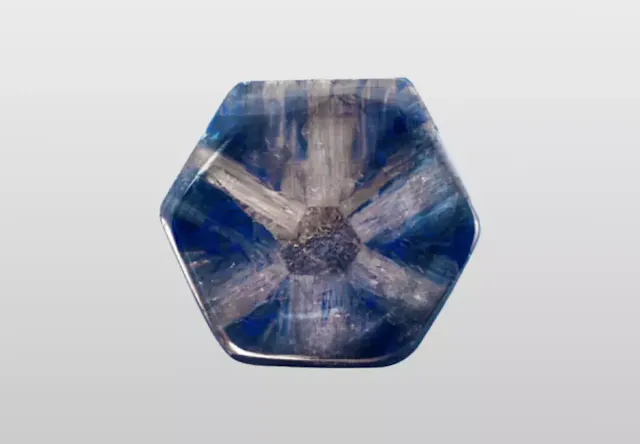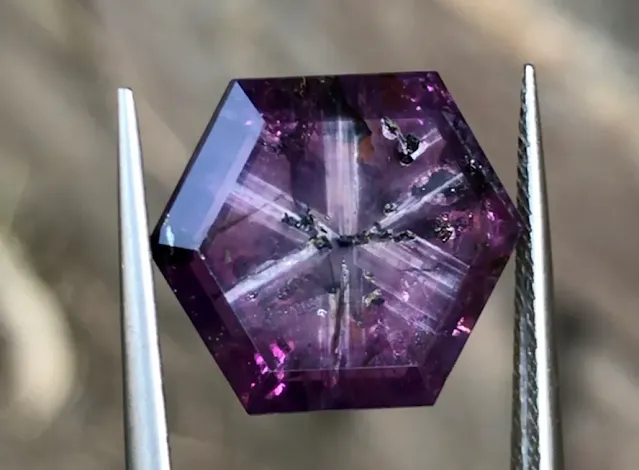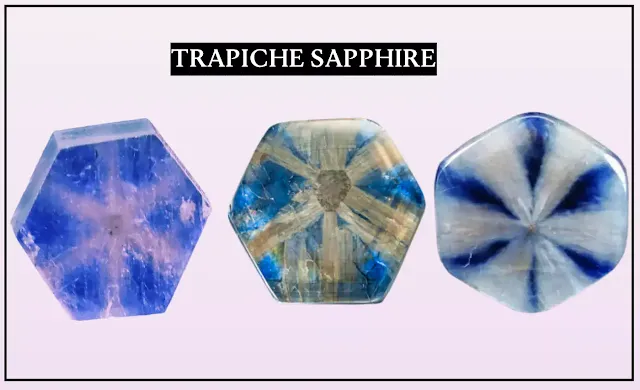Trapiche Sapphire
Trapiche sapphire is a rare variety of sapphire known for their unique six-rayed star pattern. Trapiche sapphires have a distinctive six-pointed star-like pattern radiating from the center of the stone. These "spokes" are actually caused by inclusions, tiny impurities trapped within the sapphire during its formation.
The name "Trapiche" comes from the Spanish word for "spoked wheel" a type of sugar mill with a spoked grinding wheel. The resemblance between the wheel's spokes and the gemstone's pattern is what led to this name.
What causes the star pattern in Trapiche sapphires?
The star pattern in Trapiche sapphires, a truly unique feature, is caused by the uneven distribution of microscopic inclusions within the gemstone. There are two main theories for how this happens:
Unmixing of impurities: During the sapphire's formation, impurities can become trapped within the stone. As the sapphire cools, these impurities can migrate and concentrate along specific planes, forming a six-rayed star-like pattern. These planes are often associated with dendritic growth patterns, where the sapphire crystal grew in a branching, snowflake-like manner.
Colorant concentration: In some rare cases, the star pattern might be caused by the uneven distribution of the coloring agents themselves, rather than impurities. The exact reasons for this are still not fully understood, but it results in a dramatic contrast between the star-shaped colored regions and the lighter background.
Both mechanisms create channels within the gemstone that scatter light differently depending on the cutting style and light source, resulting in the beautiful asterism or star effect.
Properties of Trapiche sapphire
Color: Trapiche sapphires can come in a variety of colors, even though blue remains the most sought-after and valuable one. Here's a breakdown of their color range:
- Classic Blue: This is the most prized color for Trapiche sapphires, with deeper shades being particularly desirable.
- Fancy Colors: Trapiche formations can also occur in less common colors like green, yellow, and even purple. These "fancy" colored Trapiche sapphires can be quite stunning, but it's important to note that the star pattern might be less distinct in lighter colored stones.
Transparency: Trapiche sapphires can range from transparent to translucent. The transparency will depend on the cutting style and the presence of inclusions.
Luster: Trapiche sapphires have a vitreous luster, which is a glassy and brilliant shine.
Hardness: Trapiche sapphires, like all sapphires, have a hardness of 9 on the Mohs scale, making them extremely hard and scratch-resistant. This makes them a good choice for everyday wear jewelry.
Cleavage: Sapphires have a distinct parting or cleavage along basal planes. This means they can be chipped or fractured more easily with a blow in a specific direction. However, a skilled cutter can usually work around the cleavage to create a durable gemstone.
Fracture: Sapphires will fracture conchoidally, meaning they will break with smooth, curved surfaces when struck.
Density (Specific Gravity): The density of Trapiche sapphires is around 3.9 – 4.1 grams per cubic centimeter. This is a relatively high density, which is typical for corundum gemstones.
Fluorescence: Trapiche sapphires can exhibit fluorescence under ultraviolet (UV) light. The fluorescence can vary depending on the origin of the stone, but it is often inert (does not fluoresce) or weak.
Pleochroism: Trapiche sapphires exhibit pleochroism, which means they can show different colors depending on the viewing direction. This can be a helpful way to identify a genuine sapphire from a synthetic one.
Refractive Index: The refractive index of Trapiche sapphires is around 1.76 – 1.77. This is a high refractive index, which contributes to the gemstone's brilliance and fire.
Inclusions: Trapiche sapphires are known for their unique star pattern caused by microscopic inclusions. These inclusions can be needle-like rutile crystals or other minerals. The star pattern is typically six-rayed and can be very attractive.
Cut: Trapiche sapphires are typically cut to showcase their radial spoke pattern while maximizing their beauty and brilliance. The most common cuts include cabochons and faceted shapes, such as round, oval, or cushion cuts.
Rarity: How rare are Trapiche sapphires?
Trapiche sapphires are much rarer than typical sapphires. The star pattern formation is uncommon, making these stones more valuable. The rarity of Trapiche sapphires stems from the specific geological conditions required for their formation.
 |
| Trapiche Sapphire colors |
Occurrence: Where are Trapiche sapphires found?
Trapiche sapphires are found in a very limited number of locations worldwide, making them even more special. Here's a breakdown of the primary sources:
Mogok, Myanmar: This is the most famous source for Trapiche sapphires, and it's where the very first ones were discovered. Mogok has a long history of sapphire mining, and it's known for producing high-quality gems with exceptional color and clarity.
Kashmir, India: Kashmir sapphires are renowned for their rich, velvety blue color, and some mines in this region have also produced rare Trapiche sapphires. These Kashmiri Trapiche sapphires can be especially valuable due to their unique combination of color and star pattern.
Other regions: Scattered discoveries of Trapiche sapphires have been reported from locations like Western Africa, Guinea, and Sierra Leone. However, confirmed finds from these areas are very rare.
 |
| Trapiche sapphire from Myanmar |
Trapiche sapphire Jewelry
The primary use for Trapiche sapphires is in jewelry. Their unique combination of color, brilliance, and the mesmerizing star pattern make them highly sought-after gemstones for rings, necklaces, earrings, and pendants.
- Rings: The captivating star pattern of Trapiche sapphires is perfectly showcased in rings.
- Pendants: Trapiche sapphires can also be stunning centerpieces for pendants.
- Earrings: Trapiche sapphire earrings add a touch of elegance and sophistication to any outfit.
When choosing Trapiche sapphire jewelry, consider the following factors:
Color: Think about your personal style preference and what color would complement your wardrobe best. Classic blue is timeless, while fancy colored Trapiche sapphires can add a unique flair.
Cut: Since the cut greatly affects the visibility of the star pattern, opt for a well-done cabochon cut that allows the asterism to shine.
Clarity: Inclusions are what cause the star pattern, but too many inclusions can affect the overall transparency of the stone. Look for a balance between a visible star and good clarity.
Setting: The setting should complement the Trapiche sapphire and enhance its beauty. Consider a simple and elegant setting that won't detract from the star stone.
 |
| Purple Trapiche Sapphire |
Conclusion
With its rarity, beauty, and captivating play of light, a Trapiche sapphire is more than just a gemstone; it's a conversation starter, a symbol of individuality, and a reminder of the magic that can be found within the natural world. So, the next time you seek a truly unique and enchanting piece of jewelry, consider the allure of the Trapiche sapphire – a gemstone that promises to capture a piece of the starry night sky and hold it close to your heart.
Read also:
Padparadscha Sapphire: Lotus Flower Sapphire
Trapiche Emerald









